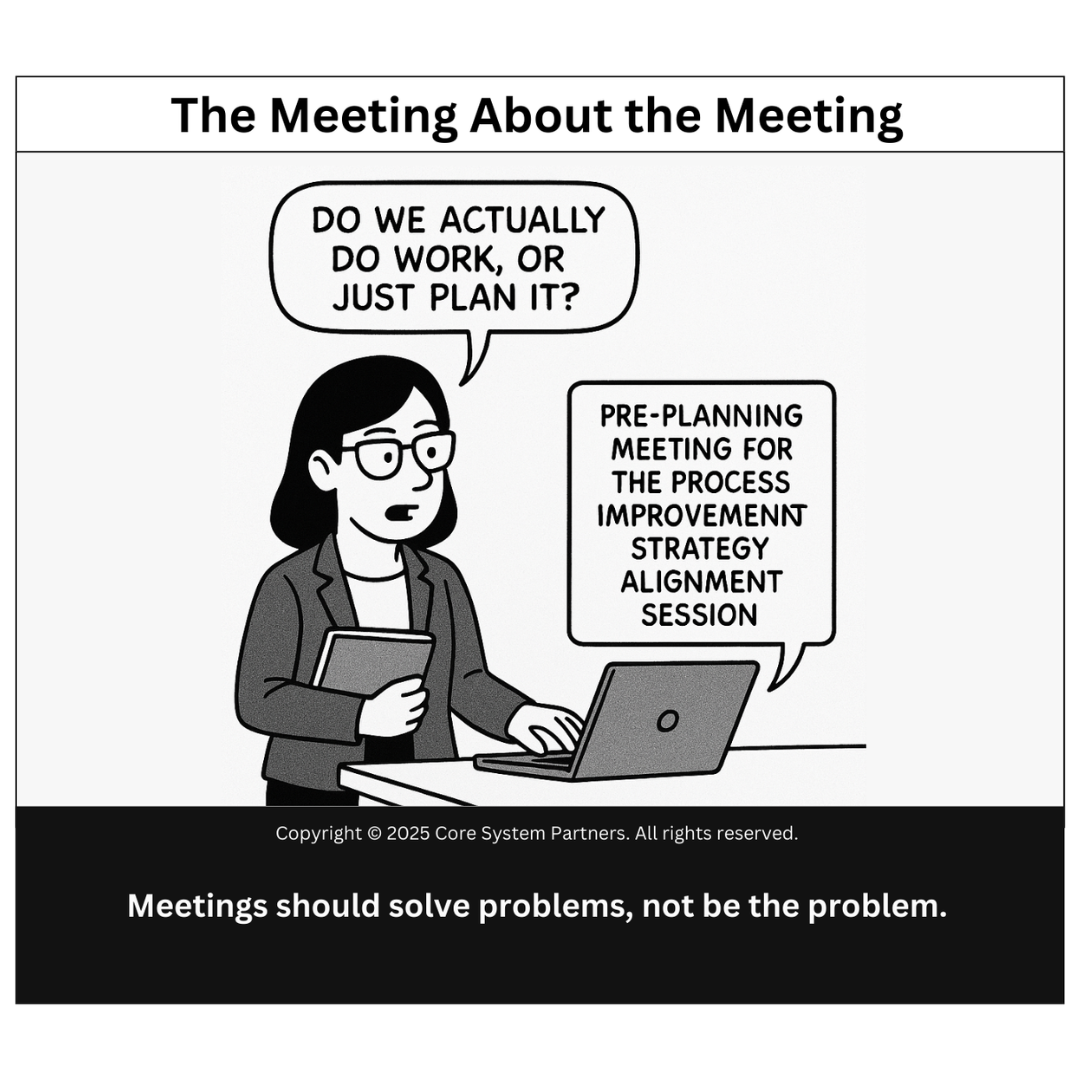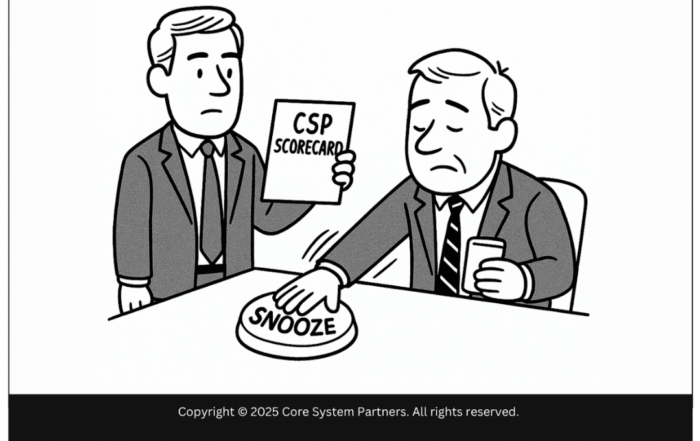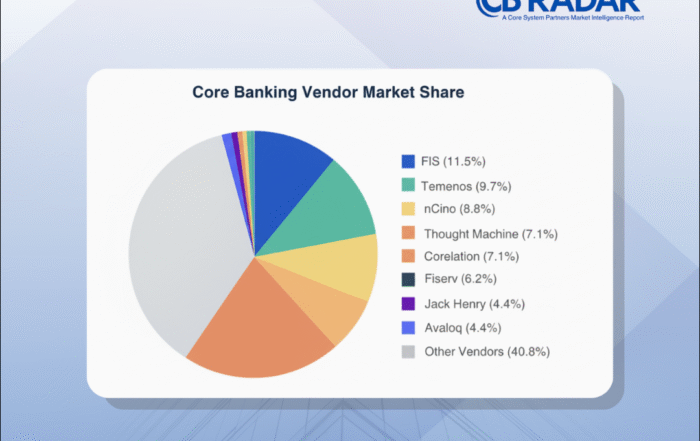
When meetings multiply without action, progress stalls—plan less, execute more.
I once joined a “pre-alignment strategy session” that was meant to prepare for the “process improvement planning kickoff.” After 45 minutes of slides, the most actionable outcome was deciding when to schedule the actual meeting. No joke. We never made it past the agenda slide.
If that sounds familiar, you’re not alone. Meetings in banking—especially during transformation programs—have a way of multiplying like rabbits. One session leads to another, then another, until the original goal is buried under layers of coordination. That’s the satirical punch of this cartoon—and sadly, it’s not far off reality.
Let’s talk about the cost of over-meeting, and how to course-correct before your core transformation turns into an endless calendar shuffle.
The Meeting Spiral: A Real and Costly Distraction
There’s a reason why teams feel stuck in endless loops of “pre-work” and “alignment sessions.” We tell ourselves we’re being thorough, strategic, inclusive. But when meetings outnumber moments of actual progress, the effort becomes counterproductive.
Here’s what starts to happen:
- Velocity stalls. Nothing moves forward until “the right meeting” happens.
- Ownership blurs. With 12 people in the room, no one feels truly responsible.
- Morale erodes. Employees start wondering if their actual job is attending calls.
- Decisions get deferred. Each meeting ends with “Let’s discuss this next time.”
We’ve seen million-dollar transformations move slower than a low-interest rate hike—not because of technology—but because no one could get out of the conference room long enough to build something.
Why This Happens (and Why It’s Worse During Core Banking Projects)
Core banking transformations are big. They’re high-stakes, cross-functional, and filled with legacy complexity. So naturally, the instinct is to gather everyone early and often. But when you don’t impose structure, it spirals.
Common drivers include:
- Fear of making the wrong call. So, we plan to plan instead of acting.
- Too many stakeholders. Legal, ops, compliance, tech, vendor, risk, frontline… and every one of them needs “input.”
- No single-threaded ownership. Without a strong transformation leader, no one curates the meeting mix.
- Culture of consensus. Collaboration is great—until it becomes an excuse for inaction.
Signs You’ve Entered the “Meeting About the Meeting” Loop
Here’s how you know your project’s becoming more calendar than execution:
- You spend more time scheduling meetings than preparing for them.
- People show up asking, “Wait, what are we here for again?”
- The phrase “Let’s take that offline” shows up in every meeting—and never gets followed up.
- You need a meeting just to recap what was discussed in the last meeting.
Let’s be blunt: planning is essential, but activity ≠ productivity.
What Productive Meetings Actually Look Like
A good meeting should do one of three things: decide, solve, or unblock. Anything else can probably be a Slack thread or a 3-slide update.
The best meetings are:
- Structured. Clear agenda, clear purpose, clear outcome.
- Short. 25 minutes > 60 minutes.
- Selective. Only those directly responsible or impacted.
- Action-oriented. Every meeting ends with next steps, names, and deadlines.
- Self-regulating. If a meeting isn’t serving its purpose anymore, it disappears.
How We’ve Helped Banks Break the Meeting Cycle
One client of ours was spinning through five separate governance layers just to approve basic workflows for a digital onboarding program. It was death by alignment. Each group had its own steering committee, its own cadence, its own documentation.
We introduced a “Decision Hub” framework, where every project milestone had a single decision owner, and meetings were only held when those decisions needed to be made. Everything else moved asynchronously. The result?
- 50% reduction in meeting volume.
- Major milestones delivered 3 months ahead of plan.
- Teams regained time and focus for the actual transformation work.
A Few Ground Rules to Run Meetings Like a Transformation Pro
You don’t have to kill all meetings. Just the bad ones. Here’s how:
1. Default to “no meeting.”
If it can be done in a two-paragraph status note or a call with two people, do that instead.
2. Decide who decides.
Don’t gather 12 people to decide what one person is actually accountable for.
3. Set the meeting outcome before the meeting begins.
If it’s not clear what will be different after this meeting, cancel it.
4. Use a running decision log.
Keep a shared doc that tracks what was decided, by whom, and when. Refer to it instead of recapping everything from scratch.
5. Establish a “kill switch.”
Every team should feel empowered to cancel recurring meetings that no longer deliver value.
The Bigger Picture: Transformation Shouldn’t Feel Like a Waiting Room
When you’re transforming a core banking platform, you’re not just installing tech. You’re rearchitecting how your bank thinks, operates, and competes.
That requires focus. Decisions. Momentum.
And none of those things happen when you’re stuck in back-to-back alignment meetings with no runway for execution.
Final Thought: Less Talk. More Progress.
The cartoon gets it right: when meetings become a parody of themselves—layered, bloated, and unclear—we’re not working anymore. We’re performing “work theater.”
Transformation isn’t about talking about the work. It’s about doing the work. Let’s make sure our calendars reflect that.
Ready to Assess Your Execution Readiness?
Not sure if your team is aligned—or just busy aligning?
Take our Core Banking Transformation Readiness Assessment to identify where your bank is overplanning, under-delivering, or just stuck in the “meeting about the meeting” loop.
Because at the end of the day, you can’t workshop your way to transformation. You’ve got to act.
#CoreBankingTransformation #CoreBankingOptimization





